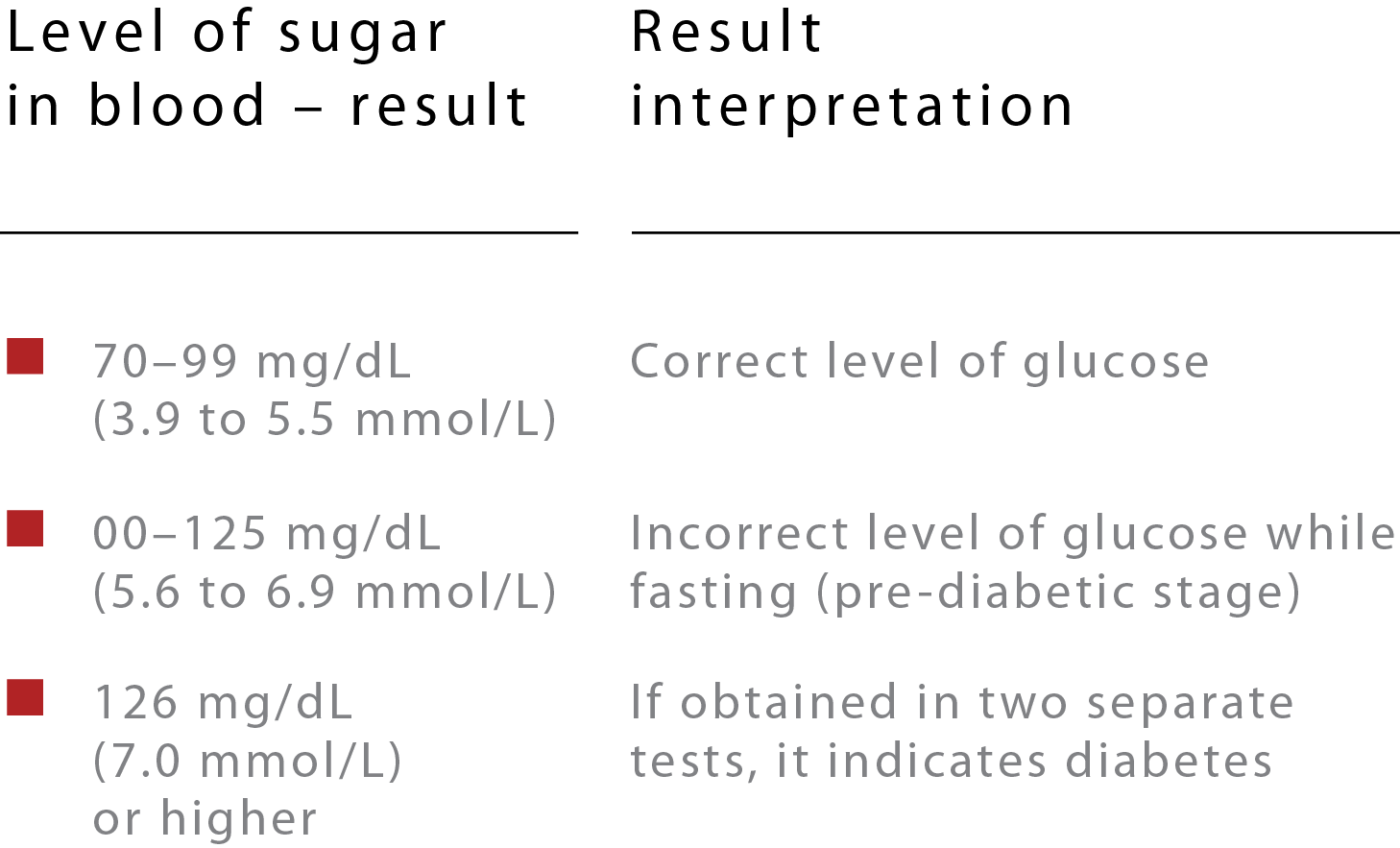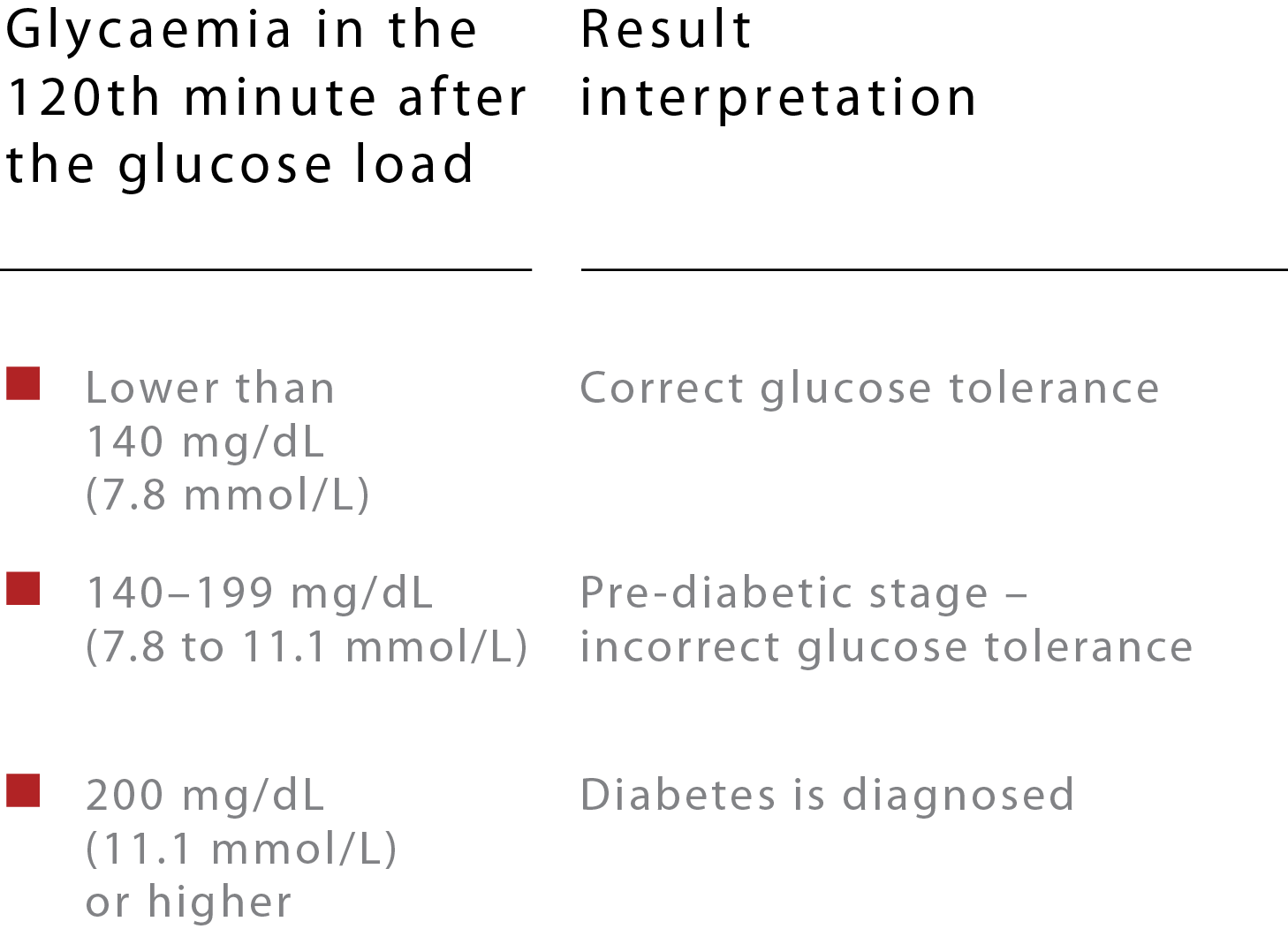
“You don’t want to eat such a sweet granny, don’t you? Your blood sugar will skyrocket.”
A blood sugar (glycaemic) test is performed primarily for the diagnosis of diabetes, but glucose levels should also be monitored in healthy people.
The level of glucose in the blood needs to be examined:
![]() In the case of any symptoms of hypoglycaemia or hyperglycaemia
In the case of any symptoms of hypoglycaemia or hyperglycaemia
![]() Routinely – as a part of a laboratory test, especially for people at risk of developing diabetes (in people over 40 years of age, overweight or obese, with a genetic risk of diabetes);
Routinely – as a part of a laboratory test, especially for people at risk of developing diabetes (in people over 40 years of age, overweight or obese, with a genetic risk of diabetes);
![]() Regularly – people suffering from diabetes measure sugar level even several times a day;
Regularly – people suffering from diabetes measure sugar level even several times a day;
![]() Diabetics test their blood glucose levels at home using a glucose meter.
Diabetics test their blood glucose levels at home using a glucose meter.
![]() NoteGlycaemic test with a home glucose meter is not a diagnostic result. The test should be performed in a laboratory. The result on a household glucose meteris vulnerable to a measurement error of up to 15% of the result (ISO standard ISO 15197:2015).
NoteGlycaemic test with a home glucose meter is not a diagnostic result. The test should be performed in a laboratory. The result on a household glucose meteris vulnerable to a measurement error of up to 15% of the result (ISO standard ISO 15197:2015).
Glucose testing can be performed while:
![]() Fasting – do not eat or drink anything except water 8 hours before the test
Fasting – do not eat or drink anything except water 8 hours before the test
![]() After a meal – a post-meal glycaemic test is performed 2 hours after the meal (e.g. at home, using a glucose meter)
After a meal – a post-meal glycaemic test is performed 2 hours after the meal (e.g. at home, using a glucose meter)
![]() At any time – a random test of blood glucose can be performed at any time, it is not necessary to fast – an incorrect result of the sugar level does not constitute the basis for the diagnosis of diabetes. In such a case it is necessary to conduct further tests (fasting sugar test; oral glucose tolerance test)
At any time – a random test of blood glucose can be performed at any time, it is not necessary to fast – an incorrect result of the sugar level does not constitute the basis for the diagnosis of diabetes. In such a case it is necessary to conduct further tests (fasting sugar test; oral glucose tolerance test)
Blood glucose levels – the norm
Diabetes is diagnosed based on glycaemia exceeding the norm in a fasting blood sugar test (double measurements), in the oral glucose tolerance test (OGGT).
Normal blood glucose result ranges between 70 and 99 mg/dl. In the case of a higher result (126 mg/dL or more), the test should be repeated several days later.
Venous blood glucose levels:

Oral glucose tolerance test (OGGT):

Low/high blood sugar –causes and symptoms
Low level of sugar in blood – causes
![]() Undiagnosed diabetes
Undiagnosed diabetes
![]() Food poisoning – with vomiting and diarrhoea
Food poisoning – with vomiting and diarrhoea
![]() Intense physical effort
Intense physical effort
![]() Some weight loss diets (not enough carbohydrates in the diet)
Some weight loss diets (not enough carbohydrates in the diet)
![]() Consumption of large amounts of strong alcohol
Consumption of large amounts of strong alcohol
![]() Stress
Stress
![]() Intake of larger portions of simple carbohydrates (with reactive hypoglycaemia)
Intake of larger portions of simple carbohydrates (with reactive hypoglycaemia)
![]() In diabetics: providing too much insulin, skipping a meal, eating too little
In diabetics: providing too much insulin, skipping a meal, eating too little
Symptoms of hypoglycaemia
![]() Early symptoms: feeling hungry, nausea, weakness, paleness, dilated pupils, anxiety, sweating (so-called cold sweat), shaking hands
Early symptoms: feeling hungry, nausea, weakness, paleness, dilated pupils, anxiety, sweating (so-called cold sweat), shaking hands
![]() Severe hypoglycaemia: orientation disorders, speech disorders, convulsions, coma
Severe hypoglycaemia: orientation disorders, speech disorders, convulsions, coma
High level of sugar in blood – causes
![]() Undiagnosed diabetes, insulin resistance
Undiagnosed diabetes, insulin resistance
![]() Pancreatic disease (pancreatitis)
Pancreatic disease (pancreatitis)
![]() Post-traumatic stress
Post-traumatic stress
![]() Cushing’s syndrome
Cushing’s syndrome
![]() Endocrinologic diseases
Endocrinologic diseases
![]() In diabetics: poorly treated diabetes (e.g. incorrect insulin doses, a skipped dose)
In diabetics: poorly treated diabetes (e.g. incorrect insulin doses, a skipped dose)
Symptoms of hyperglycaemia
![]() Heavy urination
Heavy urination
![]() Increased thirst
Increased thirst
![]() Dry mouth
Dry mouth
![]() Feeling unwell, weak, sleepy
Feeling unwell, weak, sleepy
![]() Headaches
Headaches
![]() Blurred vision
Blurred vision
Back Next
![]()
Simple Medical Procedures:80% complete
